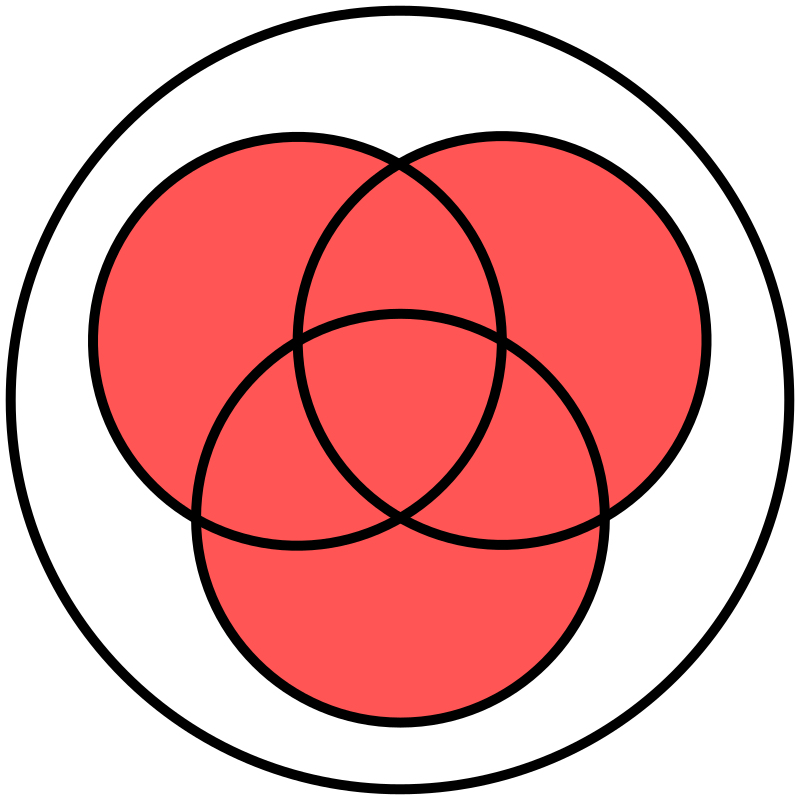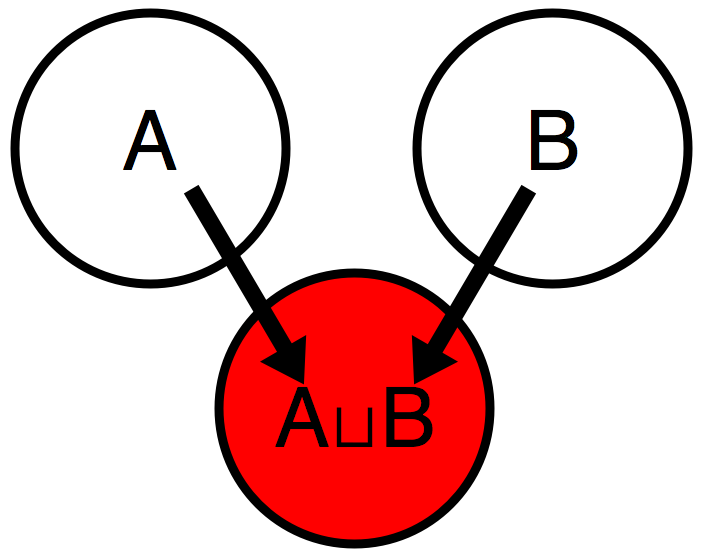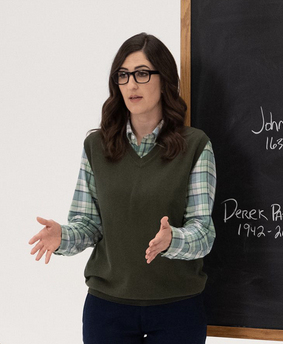Set Theory for Content
I'm going to keep this short, because I've tried two drafts, and they got boring when they got long.
I've written up a more abstract version to describe broad uses of math in feature development in part 1. Part 3 covers prioritizing content in limited interfaces.
- Union: Social Media Platforms
- Disjoint Union: Journalism
- Intersection: Chat (1 on 1 or group)
Union
In the first (union), content is all slapped together.

This as a default makes moderation very hard. Once this becomes the default assumption of a digital space, compromises need to be made.

This model of joining all content together and hoping/making the best rise to the top is dangerous. By encouraging subplatform interactions and groups, and allowing growth to mean positive experiences rather than engagement, this model has a future. Otherwise, the options are more invasive, frustrating, and/or addictive. At the scale the giants currently operate at, there isn't a way to meaningfully 10x the userbase without discovering a much more populace planet full of feed-loving aliens. Focusing on scaling down, and personalizing, with an eye towards how to use a fleeting hold on giant piles of money to help the earth would be a nice mission for them.
Disjoint Union
In the second, disjoint union, sets of content are combined but keep their original labels.

If this was just a "normal" union, then we might call the third set C. But because it's a disjoint union, any piece of content retains some additional information about which set it came from. For journalism, this is called the "separation of church and state," and refers to a clear division between articles and advertising.
For complicated, sad, and (in the case of the "pivot to video" fraud specifically) criminal reasons, journalism is struggling under this model. Relative to platforms, it's slow to tell a story and inform with accuracy. And it's terrible to blend ads in with real articles. And giving up tons of real estate to nonsense ads makes the rest of the site/paper look bad and untrustworthy. When media tries to be a platform with their own content/ads, it looks as bad as it is.
Some TV networks are looking more like state media than independent local orgs, complete with "must run" segments from Sinclair Broadcasting. Others have started finding ways to sell their data and tools to partners for a different kind of platform.
The outlets that have been most surprising and successful in embracing a disjoint union model of content are Teen Vogue and Buzzfeed. Respectively, a large part of their content is clickbait. In the former case, you can get makeup ideas and find out what's what with your favorite celebrity gossip... or you can get an introduction to Karl Marx. On the latter, you can find out which Good Place character you are (I'm a Janet by the way, though I definitely have some Chidi-like tendencies... anywho) or you can read about the latest crimes of the president... through their exclusive report on the matter?

Both outlets have done this a few times, and I'd like to talk with someone there about the rationale at some point. Silicon Valley logic would suggest that they just let the click-bait factory run. But for whatever reason, they've decided to embed some wokity woke lefty stuff and some of the best investigative journalism the country can do. Part of the appeal might be the novelty of such serious work coming from places associated with frivolity.
Maybe the journalists in the positions to write and investigate have more time to dive deeply.
I have no idea, but it seems sustainable and I love it. It's the science stuff from the Epcot Center in Disney World. It's the glass of water after too much ice cream. It's Death Cab For Cutie dedicating their performance to Christine Blasey Ford. It's the overpriced wasteful razor company pleading with men to do better. A huge platform tacking on messages is fantastic. It doesn't fix everything, but even if it's only because it's so unexpected, it has an impact.
If a mushy model pushed around by platforms and big financial interests makes it hard to do real journalism, this seems like a very good solution. Mix a content factory, and all the problems therein, and add the real, important work to it.
I'm not talking about donating money as a tax-dodge and PR move. I'm not talking about greenwashing by putting the most modest effort into the environment while destroying it off-camera.
I'm talking about knowing what's good, and using what you have to make a positive impact. The increase of democrat voter registrations as a result of Taylor Swift's plea outsized the entire membership base of the DSA. If every celebrity did that, and if every concert, play, class, game loading screen, and even football game started with a commitment to positive change, not to a Union or a union operation, but to specific challenges we face right now, what could we accomplish?
Intersection
Some companies and services are based on the premise of direct, synchronous or asynchronous interactions between people.

There may be a directory or search feature that helps you find someone else. This is only a way to get to the real content though, which is a conversation. Here, you can write and receive messages. The model for this system is intersection, and when you're talking about connections between people, this (very incompletely, because it is an abstract basic model, which are always wrong) means an assumption of agreement and assent, if not, consent.
Here, the base assumptions of the system are wildly different. You sign into a chat room. You choose your friends, groups, and partners. There are definitely problems within this model as well, but it's not a bad model to start from. When Facebook started there was some assumption that you would be friends with people you knew. "Friending" was building a connection.
Model Limitations
Especially on complex sites, these models don't account for every feature (and platforms will have content across the site that behaves more like one or another), but we're pretty good at grouping content into categories and authors. A given page or conversation of union modeled content might be easy to predict the types of conflicts and abuses that would come up (especially if you had been working on these issues for a decade). But a focus on features to "improve" the feed might not be the best solution.
If 5 people have a nice conversation that gets ruined by a sixth person joining in, why not invite give those 5 a chance to start their own chat room together where they can pick up those jovial conversations again?
A cooldown period for that 1 person? How does their identity factor in? What about the content of all the messages sent?
Overtime, the feed might even look a little more like a lobby where people find themselves having the most fun in chats and groups.
At some point we got very afraid of bubbling, when really, the process of cramming everyone together has created a lot of work, harassment, and given a microphone to some very hateful stuff. If the intersection-esque features are inherently about intentional separation and isolation, why not have better tools and make assumed defaults more opt-in, or give the choice for how social you want to be. Some conferences have started to provide tags to indicate how social you want to be. Having been to a few conferences, this seems like a great idea.
And now I come to the part where a product manager and I may disagree. What if moving away from a union and towards disjoint union (clearly mark boundaries or even put barriers between types of content) or intersection (make more interactions opt-in) ended up costing the company money?
And, well, good should override lucrative, even to the point where "good therefore lucrative" should be looked on with suspicion. If only for pragmatic reasons, if the good happens to go away, and the lucrative is still there, then there's momentum on a no longer good path. Also, it risks inflating the goodness of the good and may offer only suboptimal forms of the good, when better and best happen to make no money at all.
Risks and Absorbing Elements
The risk to intersection is in its absorbing element (covered in the last post) of "nothing." If you intersect with nothing, you get nothing back. In other words, if set A is ø, the null set, and you intersect it with set B, you will get ø, the null set, because there is nothing between those two circles. What if no one wants to interact? What if no one wants to talk, or join my group? These are all concerns of intersection.
With Union, the concern is with conflict because everyone is there (The absorbing element of union is everything, so everything combined with anything gets you everything). The best solutions are within features and defaults seen in disjoint union and intersection scenarios.
As for disjoint unions, there is no one particular boogeyman for an absorbing element. Having a strong money making function as well knowing what good long-term projects could do for the world might help.
Final Thoughts
The social media sites we have are all big enough to encompass a ton of arrangements of content. If we see these variations as primarily a union, disjoint union, or intersection model, then it's easier to predict risks and question our reasoning when building and using them.
Another thing to note is that although this type of analysis can be used at a page, feature, or site level to classify the primary model of content, it can get even more fined-grained and potentially automated. For example, words like "AND," "OR" and "JOIN" may hint at, if not meaningfully describe the set-theoretical content model of a given interface/experience.
Next time...
Popularity and Ranking in a Finite World.